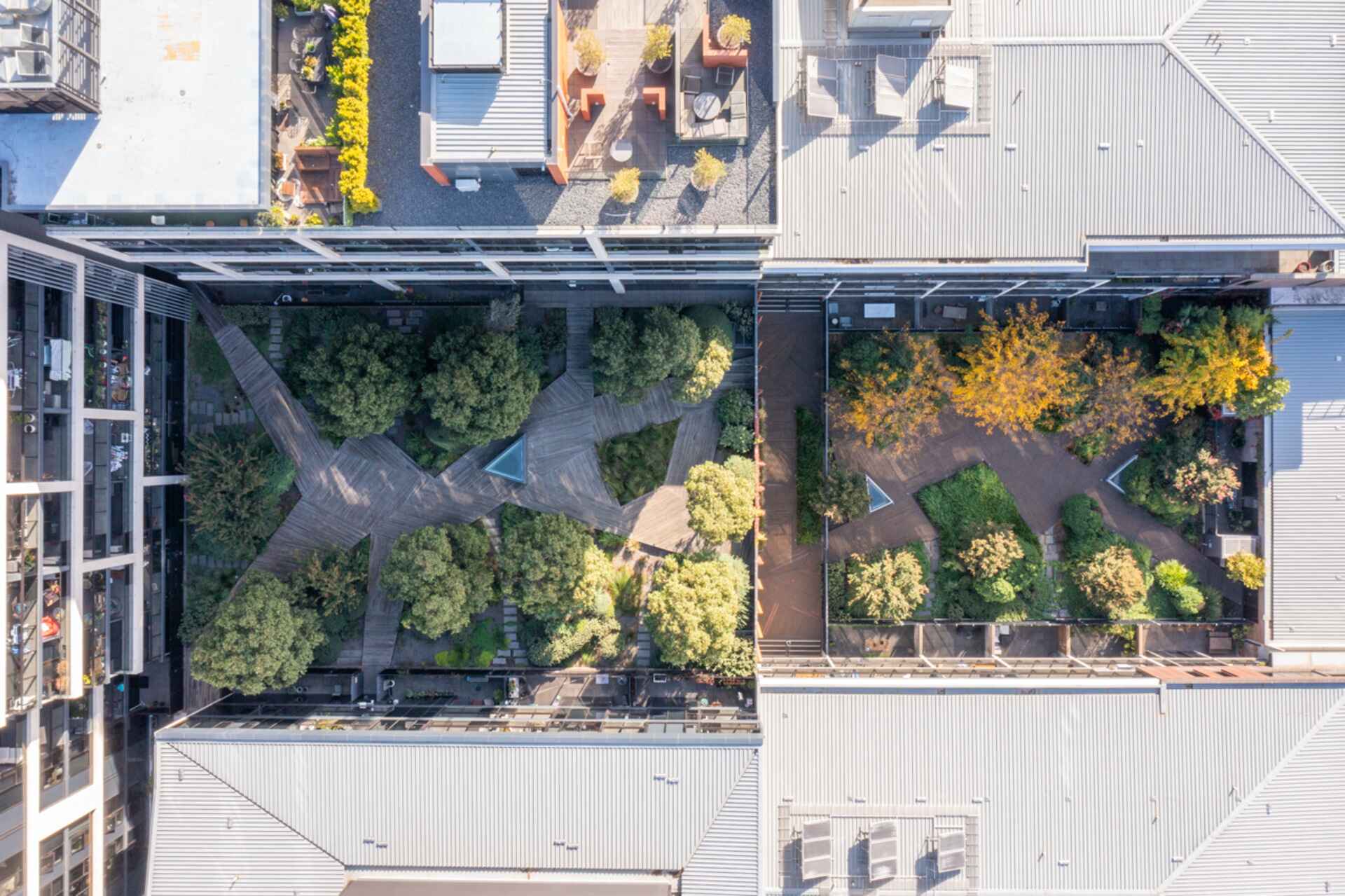Exploring the Importance of Biophilic Design in Modern Architecture
Biophilic design brings nature into modern architecture, boosting well-being, productivity, and sustainability in homes, offices, and public spaces.
.webp)
Biophilic design bridges nature and the spaces where we live and work. This type of design combines elements like sunlight, plants, natural materials, and fresh air. It comes with many benefits, including improved health, focus, and well-being. It's used widely in architecture and city planning. Biophilic design helps create more comfortable spaces, connecting us to the natural world. Evergreen Infrastructure takes this even further. We blend long-lasting, eco-friendly systems with nature-focused design.
As cities grow and technology shapes how we live, many people spend more time indoors and less time in nature.
This shift often results in increased stress, fatigue, and a sense of disconnection from the natural world.
Biophilic design offers a powerful solution. It includes designing buildings and spaces that bring nature back into our daily lives.
It combines natural light, fresh air, plants, and organic materials. Biophilic design helps create places that feel calming, healthy, and inspiring.
This design approach involves more than adding greenery. It's about building a stronger bond between people and the natural world.
From homes and offices to city parks and sidewalks, biophilic design can be used at every scale.
In this article, we'll discuss what biophilic design is, where it comes from, and its benefits. We'll also talk about how it's used in modern architecture and city planning today.
What Is Biophilic Design?
The biophilic design concept is used in architecture and urban planning.
It involves creating buildings and green spaces that help connect people more closely with nature.
The word "biophilic" comes from "biophilia," which means "love of nature."
This design style includes using natural elements, such as:
- Natural light: Maximising sunlight through windows, skylights, and light wells.
- Plants and vegetation: Indoor plants, vertical gardens, and green roofs.
- Water features: Fountains, ponds, waterfalls, or aquariums for visual and auditory stimuli.
- Fresh air and natural ventilation: Operable windows, atriums, and breezeways.
- Natural landscapes: Outdoor views of greenery, trees, or bodies of water.
- Animals: Birds, butterflies, or even pets in certain environments.

Biophilic design makes people feel more relaxed, happy, and healthy. This is achieved by including parts of the natural world in everyday spaces.
For example, large windows let in sunlight. Indoor gardens and water features add life and movement.
Even simple touches like wooden furniture or nature-inspired shapes can make a difference.
Biophilic design is not just about style. It's about how a space feels and works for the people in it.
Spending time in nature lowers stress, improves mood, and helps people think more clearly.
That's why architects and designers are using biophilic design more and more. The goal is to build spaces that support both body and mind.
What's the Philosophy Behind the Biophilic Design Approach?
The biophilic design philosophy is simple: people need nature.
We have an innate biological connection to nature. Our brains and bodies still respond best to natural sights, sounds, and spaces.
But in today's world, many people spend most of their time inside buildings, away from nature.
Biophilic design aims to fix this issue. It's based on the idea that connecting with nature is necessary for our well-being.
This design approach reaffirms that even small touches of nature can improve how we feel and work.
It also recognises nature as a teacher.
Biophilic design often copies natural system patterns to make spaces that feel calm and clear.
Curved shapes, flowing layouts, and natural materials like wood and stone all play a role.
At its core, the biophilic design approach is about respect for nature, people, and the connection between the two.
It reminds us that we are part of the natural world, not separate from it.
By bringing nature into our built spaces, we create places that support both human life and the planet.
The Six Elements of Biophilic Design
The six elements of biophilic design were proposed by Stephen R. Kellert. They include:
- Environmental features
This element involves the direct presence of nature in the environment. For example, sunlight, fresh air, plants, water bodies, and natural sounds.
- Natural shapes and forms
It includes organic, non-linear, and biomorphic forms that reflect the patterns and geometry found in nature. This includes leaf patterns, spiral staircases (like a seashell), arches, and tree-like columns.
- Natural patterns and processes
These are temporal, spatial, and sensory dynamics that mimic how nature behaves and changes. This can include daylight rhythms (circadian lighting) or weather simulations (like rain walls).
- Light and space
It includes designing spaces that use natural light, shadows, and openness. These elements improve comfort and orientation.
- Place-based relationships
These are designs that reflect the local ecology, culture, and history. Examples include using regionally sourced materials, indigenous plants, or culturally significant motifs.
- Evolved human-nature relationships
This refers to deeper psychological and cultural connections to nature that have evolved over millennia.

Benefits of Biophilic Design
Biophilic design brings many benefits to people and the spaces they use. Here are some of them:
- Better health
Natural light, clean air, and greenery can lower stress. They can also reduce blood pressure and boost your immune system. People often feel more relaxed in these spaces and well.
- Improved focus and thinking
Views of nature and calm surroundings help people stay focused, learn faster, and be more creative. This is great for schools and workplaces.
- Stronger emotional well-being
Natural spaces make people feel safe, calm, and connected. They can lift moods and support mental health.
- Lower energy use
Using sunlight and airflow means less need for lights and air conditioning. This saves energy and cuts costs.
- More welcoming spaces
Biophilic design makes homes, offices, and public areas feel warm, open, and inviting.

In short, biophilic design supports both people and the planet by making everyday spaces feel more alive and balanced.
Biophilic Design in Architecture and Urban Planning
Biophilic design is becoming a key part of both architecture and urban planning.
As cities grow and more people live in busy, built-up areas, the need for nature in everyday spaces is stronger than ever.
Architects and planners are using biophilic ideas to make buildings and neighbourhoods healthier.
This also makes urban environments more connected to the natural world.
In architecture, this means adding:
- Large windows
- Indoor gardens
- Green roofs
- Green walls
- Urban farms
- Natural materials like wood and stone
These features bring light, fresh air, and a sense of calm into homes, schools, and offices.
Urban planning takes these ideas outdoors.
City planners design parks, green walkways, tree-lined streets, and water features to give people access to nature.
These spaces help reduce heat, improve air quality, and support mental well-being.
By combining natural elements with smart design, biophilic planning helps cities feel more human.
It creates places where people can enjoy both the energy of city life and the peace of nature, all in the same space.
How Does Evergreen Infrastructure Implement Biophilic Design?
Evergreen Infrastructure puts nature at the centre of design.
We focus on long-lasting, eco-friendly green designs that work with the environment, not against it.
Biophilic design plays a key role in how our green spaces are planned and built.
We use the latest biophilic design research to integrate nature into your space.
Through each project, we use natural materials, green spaces, and smart layouts to support both people and the environment.
Our goal is to blend beautiful built structures with living elements like plants, trees, and water. Through urban greening, we can make cities healthier and more comfortable.
Here are some ways Evergreen Infrastructure uses biophilic design:
- Green roofs and green walls
Evergreen Infrastructure creates biodiverse green roofs. One example is the 400 m² biodiversity green roof in Kensington. These green structures cool buildings, support wildlife, and improve air quality.
- Urban farms and gardens
Evergreen Infrastructure creates thriving edible gardens, bringing fresh food closer to you. These spaces foster community, reduce heat, and promote healthier lifestyles.
- Therapeutic landscapes
We create sensory-rich landscapes that offer a place to relax and take a break from the outside world. These spaces help reduce stress thanks to their therapeutic effect.
- Smart, site-driven design
We start with detailed site assessments (light, soil, wind). Then, we select climate-appropriate plants and sustainable water systems. We also blend natural materials and thoughtful layouts into both private and public spaces.
By combining smart planning with natural elements, Evergreen Infrastructure supports a healthier, greener future for everyone.
Understanding the Importance of Biophilic Design Architecture
Biophilic design is more than a trend. It's a vital approach to creating healthier, more human-centred spaces.
Bringing nature into buildings and cities helps people feel better and connect more deeply to the world around them.
If you're ready to incorporate the power of biophilic design into your next project, Evergreen Infrastructure can help.
We have years of experience creating green roofs, green walls, and sustainable landscapes. This gives us the skills to turn any space into a vibrant, nature-connected environment.
Would you like to design a home, workplace, or public space? Either way, we will guide you from concept to completion with smart, site-specific solutions that last.
Visit our site to learn more or start your project today.
{{cta}}
We create green oases in urban settings
We'd love to discuss how we can partner to bring innovative, sustainable solutions to your urban environment.
.webp)
.webp)
.webp)


